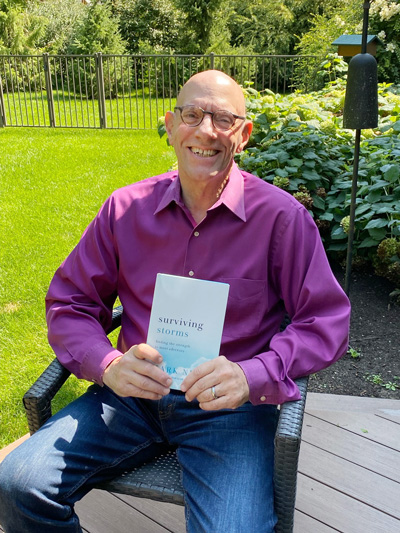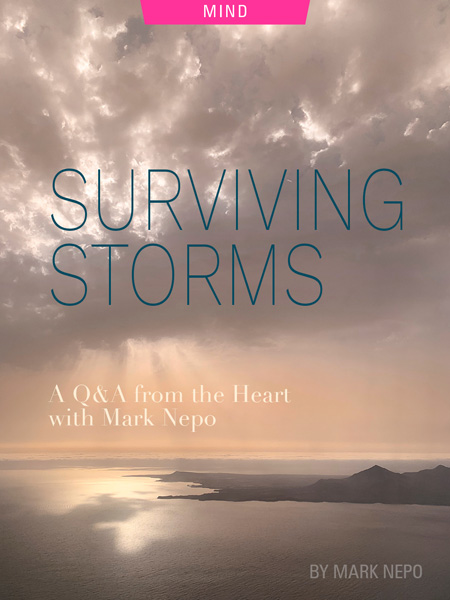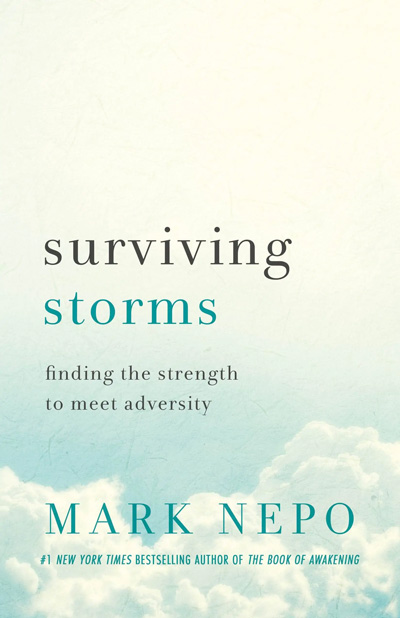Estimated reading time: 7 minutes
A poetic exploration of the cultural and personal storms that befall us all as humans — and the inner practice to survive them
—

I am excited to share that my new book, Surviving Storms: Finding the Strength to Meet Adversity, will be published this September by St. Martin’s Essentials. It is a book that has taken three years to retrieve and shape. Like everyone, my understanding of things has been shaped by the pandemic. But I continue to believe in the goodness we are born with and the courage we each have to summon to let that goodness into the world. We need each other more than ever. Each generation is challenged to choose love over fear. It is our turn. The following conversation explores the new book and the terrain it enters. ~ Mark Nepo
Q: What are you exploring with Surviving Storms?
We live in a turbulent time. Storms are everywhere, of every shape and size. And like every generation before us, like every soul’s journey on Earth, we must learn the art of surviving storms, so we can endure and build a better world. The reason heartwork is so important in surviving storms is that, as a tree needs to deepen its roots and widen its trunk to endure the force of unexpected storms, we need to know our true self so we can deepen our roots and solidify our connection to all Spirit and all life. Then, we, too, can endure the force of unexpected storms. This is especially relevant now. Every generation has its share of turbulence and chaos—personal storms, relational storms, life storms. And all the traditions offer practices and resources to help us be strong enough and kind enough to meet the challenges of our day. It is our turn to rediscover these practices and resources in order to repair ourselves and our world. All this is inner practice. All this is heartwork that we each need to personalize. This is what Surviving Storms explores.
Q: Can you describe the journey this book takes us on?
The first two chapters of this book describe the storms of our time—where we are and how we got here. They outline the fault lines of our refracted society, including: our loss of relationship, the isolation of technology, the dissolution of reality, the loss of a common good, the press of narcissism over inclusion, and our addiction to violence. The third chapter explores the nature and life of storms. And the fourth chapter unpacks the purpose of goodness. The rest of the book describes the perennial practices and resources that we can reacquaint ourselves with in order to restore our basic human nature and transcend our perceived differences. This task is nothing short of the remaking of humanity, yet one more time.
Q: Please speak to the difficulties we face today as part of a pattern in history?
The long swells of history crest and crash, century after century. The kindness and cruelty of an age expands and contracts. The openness and narrowness of how we learn either grows or collapses depending on how each generation reacts to the storms they encounter and create. As I write this, a good part of humanity is in such a collapse of narrowness, in such a contraction of cruelty. And though we have crashed, the harsh beauty of waves is that they always reform, gathering all they’ve been through to rise and crest again. Likewise, we can learn from what we’ve been through. We can expand again and open our minds and hearts. We can find our way back to kindness, if we dare to see each other in ourselves and accept the truth of what we’ve broken. Then, we can see what needs repair.
Q: You talk about the maturing of compassion. What do you mean by this?
Ultimately, loving is the practice ground for everything. Early in life, there is an initiation into the practice of compassion through the commonality of our experience with others. If I have suffered a broken heart, then when I witness your heart breaking, I can easily identify with what you’re going through. This sort of compassion, based on our common experience, is an ongoing apprenticeship that never ends. But over the years, as I’ve thinned what builds between my heart and the world, I’ve come to see that this form of compassion, dear and necessary as it is, leads to a maturing of compassion. Once our heart is opened, the practice of identifying with others leads us to the noble and necessary act of feeling compassion for those that we have no common experience with.
Q: You have a chapter called “Ten Thousand Hands.” What are you exploring here?
I offer this metaphor to explore the difference between our infinite want and our very finite reach in this world. For the heart has ten thousand hands that want to lift and hold everything, to leave no dream untried. But the life that carries the heart has only two hands. And so, intoxicated with life, we reach for more than we can carry, and meaning well, we promise more than we can ever hope to care for. In this way, we try to live as many lives as possible rather than inhabit the one life we are given. This is a common, inner tension. For as human beings, our being is infinite and unlimited, but our humanness is very finite and limited. Feeling this innate cross-purpose, we can be seduced by the want to do everything and to go everywhere—though we can’t. Without accepting our very human limits, we can inadvertently do harm to each other.
Q: Can you speak more about what it means to work with what we’re given?
Though there’s nothing wrong with working for things we want, I have found that my deepest gifts have shown themselves when working with what I’ve been given. I’ve come to see that working for what I want is often an apprenticeship for working with what I’m given. For by working with what we’re given, our soul shows itself. All of this is how the heart initiates us into the art of acceptance where, far from resignation, we are asked to be kind and useful beyond all intent.
Q: An early chapter is called “The Old World Is Gone.” What are you suggesting here?
As the pandemic spread around the world, it brought moments from my cancer journey sharply before me. One profound moment in particular echoes where we are in a compelling way. It was the moment of my diagnosis more than thirty years ago. I was sitting in a doctor’s office when I heard the words, “You have cancer.”
I was, of course, frightened and disoriented. I thought, he must have made a mistake. How could this be me? Stunned, I left that appointment reeling. But the door I had walked through to keep that appointment was gone. There was no way back to my life before that moment. Life would never be the same. The old world was gone.
I think this transformative moment has gripped the world. Collectively, the world before the pandemic is gone. There is no way back to life before the coronavirus. We have no choice but to accept the truth of what is and love our way forward, discovering the new life unlived ahead of us.
To be sure, there is nothing glorious or mysterious about disease. The cancer I had was not as important as what it opened in me. Likewise, there is nothing glorious or mysterious about the coronavirus. It can never be as important as what it is opening in humanity. As cancer was a catalyst for transformation when I was ill, we need to ask: What is the appearance of this pandemic trying to open in us and teach us? How is it transforming us as a global family?
Q: What is your hope for anyone engaging with this book?
The Hebrew word for blessing means “more life.” This is the blessing that comes from being educated by the heart—we are given more life. This is the blessing I wish for everyone who reads this book—that as a fish grows stronger for having a healthy and muscular gill, you are given more life for having an expansive and well-tuned heart.
You may also enjoy reading other articles by Mark Nepo for Best Self Magazine.

